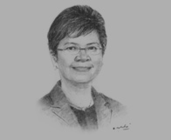OBG talks to Florence Tarriela, Chairperson, Philippine National Bank (PNB)

Interview: Florence Tarriela
How would you describe the current competitive landscape for retail banking? What is the outlook for consolidation in the sector?
FLORENCE TARRIELA: The retail banking business in the Philippines remains very competitive, with banks focusing on the expansion of their customer base, geographic reach and technology-based banking services. To improve customer support across a variety of diverse segments, banks continue to provide a wide range of innovative and customer-focused products and services. In this area, technology-based banking products and services are being enhanced, expanded and integrated more than ever before.
Strong competition among banks is also seen in consumer financing, particularly in auto and housing loans due to their growth potential and higher margins compared to wholesale lending. Fierce competition in the credit card industry has led to the launch of personalised and customised products, including ones designed for corporate consumption.
While retail banking in the Philippines continues to be dominated by a few top banks, many banks are aggressively expanding their contact points through branch and ATM networks. Medium-sized institutions are looking to continue to grow organically by applying for new bank licences in non-restricted areas.
Regarding consolidation, the central bank has undertaken initiatives to encourage mergers and acquisitions in the banking industry. Increased consolidation will lead to the emergence of larger banks with improved capacities to manage risks and diversify in an ever-changing operating environment. The biggest players are targeting smaller banks for acquisition with an eye to market leadership. Medium-sized banks are pursuing a strategy of rapid growth through the acquisition of smaller institutions.
In addition, the move towards more stringent capital requirements stipulated by the Basel III global regulatory standard will further encourage mergers and consolidation in the Philippine banking industry.
We can therefore expect that the banking industry will eventually consist of a few large, globally competitive banks complemented by smaller niche players. These would include small, specialised banks that are able to more efficiently provide financial services through microfinancing.
How can small and medium-sized enterprises (SMEs) drive growth in the industry? Is current sector oversight sufficient?
TARRIELA: The central bank requires that all lending institutions make available a portion of their total loan portfolio for the financing needs of SMEs. The central bank has further expanded SME access to mainstream financial products and services by supporting the Credit Surety Fund Programme, a credit enhancement scheme that allows members of the cooperative to borrow from banks without collateral. Some banks have made use of rediscounting facilities and inexpensive funds from government and multilateral funding agencies to keep their interest rates at competitive levels while meeting the long-term financial needs of SME clients.
At the same time, tight competition has reduced the margins banks can achieve through corporate lending, leading many banks to expand their market focus from large institutional accounts and concentrate on SMEs and individuals.
The SME and consumer markets offer better returns, given their relatively high-risk profile. Credit information and financial statements are not as readily available from most small businesses. Some banks have addressed the problem of assessing client credit worthiness with a variety of strategies, such as templates or scoring-based evaluation.
Banks now consider SME financing as a complement to their commercial lending operations. This has led to a number of banks even tailoring business lines and products with the intention of catering to the specific needs of SMEs, particularly in franchising.
You have reached the limit of premium articles you can view for free.
Choose from the options below to purchase print or digital editions of our Reports. You can also purchase a website subscription giving you unlimited access to all of our Reports online for 12 months.
If you have already purchased this Report or have a website subscription, please login to continue.

